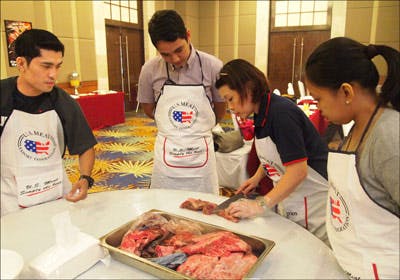USMEF Culinary Camp in the Philippines
Published: Mar 28, 2013
USMEF-ASEAN recently conducted its first U.S. Meat Culinary Camp of 2013 in Tagaytay City, Philippines. Just a two-hour drive from Manila, Tagaytay City is one of the country's most popular tourist destinations because of its beautiful scenery and cooler, high-altitude climate. The goal of the USMEF Culinary Camp program is to educate chefs, restaurateurs and other foodservice professionals about the attributes of U.S. pork, beef and lamb. Support for the program is provided through the Pork Checkoff, the Beef Checkoff Program and the USDA Market Access Program (MAP).
USMEF enlisted the assistance of key importers in assembling a list of 32 participants, which included mostly restaurant owners and chefs, but also some representatives of the retail sector. To open the two-day training camp, attendees were introduced to U.S. production, processing and grading practices by USMEF-ASEAN Director Sabrina Yin. They were also provided with an overview of USMEF programs and activities by Marketing and Communication Assistant Justin Cai. He also introduced participants to a range of useful culinary websites that will enhance their ability to utilize U.S. meat products to bolster the quality and diversity of their menus.
USMEF enlisted the assistance of key importers in assembling a list of 32 participants, which included mostly restaurant owners and chefs, but also some representatives of the retail sector. To open the two-day training camp, attendees were introduced to U.S. production, processing and grading practices by USMEF-ASEAN Director Sabrina Yin. They were also provided with an overview of USMEF programs and activities by Marketing and Communication Assistant Justin Cai. He also introduced participants to a range of useful culinary websites that will enhance their ability to utilize U.S. meat products to bolster the quality and diversity of their menus.

ASEAN Director Sabrina Yin provides a cutting demonstration at a USMEF Culinary Camp training session in Tagaytay City, Philippines
Yin was joined by guest chef Yvette Olivares Luciano of Tagaytay City’s Summit Ridge Hotel for cutting and cooking demonstrations featuring pork brisket and shoulder butt, as well as beef outside skirt, chuck roll, tenderloin, hanging tender and top blade. The program also covered a wide range of culinary techniques and tips on safe food handling and storage practices. Special guests on the event's second day were Bill Verzani, agricultural attaché at the U.S. embassy in Manila and Joycelyn Claridades, FAS-Manila marketing specialist.
“The Philippines is a critical market for U.S. meat products and we have found Tagaytay City to be a venue of growing influence and popularity in the region,” said Yin. “Interest in this training camp was very strong, not only based on the number of participants but also the high level of decision-makers we were able to attract.”
The Philippines was easily the ASEAN region’s largest market for U.S. pork in 2012 and the second-largest (to Vietnam) for U.S. beef. Exports to the Philippines raced to a very fast start in 2013, with January beef and beef variety meat exports increasing 40 percent in volume (1,161 mt) and 83 percent in value ($5.6 million) over year-ago levels. Pork and pork variety meat exports were also very strong, rising 33 percent in volume (4,290 mt) and 11 percent in value ($9.1 million) over January 201
